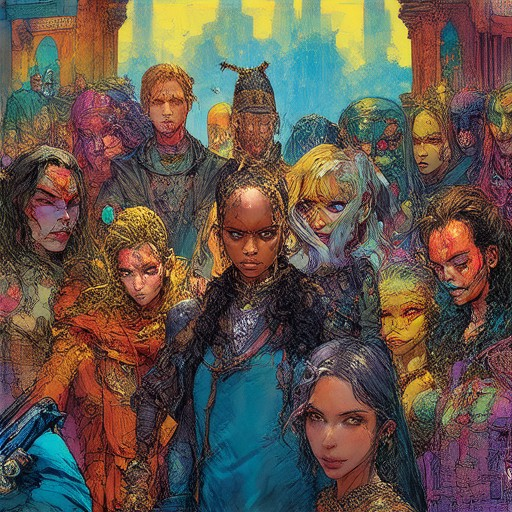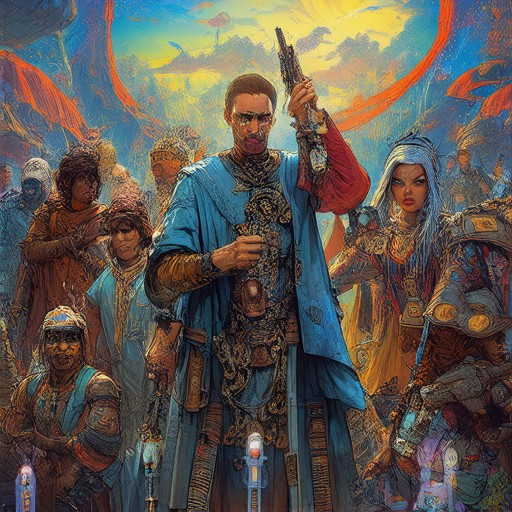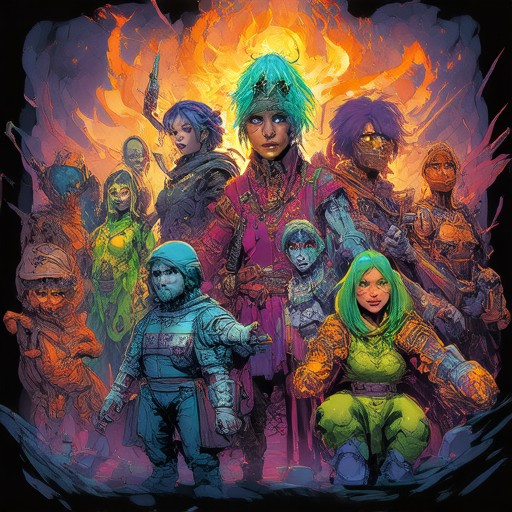Creating lifelike non-player characters (NPCs) is a cornerstone of immersive storytelling, offering writers the ability to breathe life into narratives through rich, multifaceted individuals. Whether crafting intricate backstories, assigning meaningful roles, or designing personalities that resonate with readers, the process of creating NPCs is a delicate balance of creativity and strategy. This guide delves into the essential steps and considerations needed to develop NPCs that feel authentic, engaging, and deeply connected to your story. From defining their motivations and goals to infusing them with emotional depth and believable behaviors, this comprehensive approach ensures your NPCs become indispensable assets to your storytelling arsenal. By mastering the art of NPC creation, you unlock the potential to elevate your stories, captivate your audience, and leave a lasting impact.
Key Takeaways
- Define Roles Clearly: Assign each NPC a specific function to integrate them naturally into the story.
- Develop Unique Personalities: Use traits like wisdom or humor to create memorable characters.
- Craft Rich Backstories: Histories tied to the plot add depth and emotional connections.
- Design Engaging Interactions: Natural dialogue and behaviors that fit the story’s tone.
- Provide Distinct Appearances: Visual descriptions help immersion and recognition.
- Balance NPC Quantity and Quality: 5-7 well-developed NPCs enhance the story without overwhelming.
- Set Motivations Aligned with Plot: Goals like revenge or protection drive their actions.
- Use Examples for Guidance: Examples like a wise sage illustrate effective creation.
- Seek and Implement Feedback: Refinement based on tester insights improves realism.
- Integrate NPCs into the World: Placing them in environments that match their motivations.

Effective Strategies for Creating Non-Player Characters
To create memorable and immersive non-player characters (NPCs) in your game, follow these structured steps:
- Define Roles Clearly: Assign each NPC a distinct function, such as guard, merchant, or quest giver. This clarity helps players anticipate interactions.
- Infuse Personality: Give NPCs unique traits. For instance, vary guard greetings from “Good day, stranger” to “What brings you here today?”
- Vary Appearances Slightly: Use subtle differences like uniforms, scars, or hats to distinguish NPCs while maintaining a cohesive look.
- Develop Backstories: Enhance depth by giving NPCs personal histories, like a merchant recounting travel tales or a quest giver seeking a lost item.
- Craft Dialogue: Keep conversations fresh with varied responses, avoiding repetitive lines to maintain engagement.
- Design Meaningful Interactions: Guards should offer hints or advice, adding layers to their roles beyond mere greetings.
- Test and Iterate: Through playtesting, refine NPC behavior and placement, ensuring they integrate smoothly into the game world.
For implementation, utilize game engine tools for NPC customization, balancing detail with performance efficiency. Align NPC designs with your game’s theme and consult examples from successful titles like “The Legend of Zelda” for inspiration. Document your process and seek playtester feedback to refine NPC experiences, ensuring they enrich your game and keep players invested.
Creating Believable Non-Player Characters
To create non-player characters (NPCs) that feel like real people, consider the following structured approach:
- Define Unique Personalities : Assign distinct traits to each NPC, such as extrovert or introvert, to make them relatable and memorable.
- Develop Backstories : Give each NPC a rich history that influences their behavior and interactions. For instance, a former artist turned guard may have a unique perspective.
- Craft Natural Dialogues : Use colloquial language and unique phrases to make conversations feel spontaneous and human-like.
- Design Distinct Appearances : Tailor each NPC’s appearance to reflect their role and personality, such as a chef wearing a stained apron or a noblewoman in a elegant gown.
- Engage in Role-Playing : Immerse yourself in their perspectives to understand their motivations and create authentic interactions.
- Utilize Game Engine Tools : Leverage NPC behavior tools to automate actions, allowing you to focus on creativity.
- Test and Gather Feedback : Conduct playtests to refine their realism and gather insights from others to enhance their appeal.
- Align with World Lore : Ensure NPCs’ behaviors match the game’s setting, whether it’s a medieval kingdom or a futuristic city.
- Consider Long-Term Impact : Think about how each NPC contributes to the story and their lasting effects on gameplay.
By following these steps, you can create NPCs that feel truly alive and integral to your game world.

Best Ways to Create Lifelike and Engaging Non-Player Characters
Creating lifelike and engaging non-player characters (NPCs) is essential for immersing players in your game. Here’s how to approach this effectively:
- Define Clear Roles and Motivations
- Assign distinct roles such as merchant, guard, or companion to guide their behavior.
- Give them personal motivations, like protecting a village or seeking revenge, to drive their actions.
- Craft Natural and Conversational Dialogue
- Use colloquial language and varied sentence structures to mimic real speech patterns.
- Include minor imperfections in dialogue to make it sound more human-like.
- Design Unique Visual Identities
- Create visually distinct appearances for each NPC to aid in identification.
- Vary their clothing, hairstyles, and accessories to reflect their background and role.
- Foster Dynamic Interactions
- Program NPCs to react to player actions, such as following, guarding, or interacting with the environment.
- Make their reactions realistic and contextually appropriate.
- Develop Backstories and Relationships
- Give NPCs meaningful backstories to add depth and emotional investment.
- Establish relationships with other NPCs and the game world to create a cohesive narrative.
- Align Behaviors with Game Mechanics
- Ensure NPCs’ actions and abilities align with the game’s rules and combat system.
- Balance their strengths and weaknesses to provide engaging challenges.
- Test and Iterate Based on Feedback
- Playtest NPCs to gather player feedback and identify areas for improvement.
- Iterate on their behaviors, dialogues, and visual designs to enhance engagement.
By following these steps, you can create NPCs that feel truly alive and contribute to a richer, more immersive gaming experience.

Steps to Create Non-Player Characters That Add Depth to Your Story
To craft non-player characters (NPCs) that enrich your narrative, follow these organized steps:
- Define Roles : Assign each NPC a clear function within your story. Whether they’re advisors, antagonists, or allies, knowing their purpose helps integrate them naturally.
- Assign Personality Traits : Give each NPC unique characteristics. Consider traits like wisdom, humor, or mystery to create diverse and memorable personalities.
- Develop Backstories : Craft a history for each NPC that ties into the plot. This adds depth and emotional connection, making them feel integral to your world.
- Design Interactions : Plan how NPCs respond to player actions. Ensure their dialogue feels natural and fits the story’s tone.
- Create Visual Descriptions : Provide distinct appearances for each NPC to aid immersion and recognition.
- Balance Quantity and Quality : Aim for 5-7 well-developed NPCs to avoid overwhelming the story while ensuring each contributes meaningfully.
- Set the Environment : Place NPCs within settings that align with their motivations, whether in bustling cities or remote villages.
- Use Examples for Guidance : Consider examples like a wise sage or a grumpy blacksmith to illustrate effective character creation.
- Seek Feedback : Revise and refine based on insights to enhance relatability and impact.
By following these steps, you can create NPCs that truly enhance your storytelling, making them unforgettable to both players and readers.
Key Steps to Create Realistic and Engaging Non-Player Characters
To create non-player characters (NPCs) that feel realistic and engaging, follow these organized steps:
- Define Roles and Functions : Clearly specify each NPC’s purpose in the game, whether as allies, antagonists, merchants, or quest givers. Understanding their role helps shape their personality and actions.
- Develop Distinct Personalities : Assign unique traits to each NPC. Consider their backstory, motivations, and interactions. Use tools like personality quizzes or character creation systems to ensure depth.
- Assign Fitting Names : Choose names that reflect their race, class, and background. Utilize naming conventions based on the game’s world, such as “Grunkle” for a dwarf or “Elara” for an elf.
- Design Appearances : Describe their physical attributes, including facial expressions, clothing, and accessories. Provide visual aids like sketches to inspire artists and maintain consistency.
- Craft Dialogues : Write dialogue samples that match their personality. Show examples of how they interact with the player and other NPCs to illustrate their nature.
- Establish Behaviors and Actions : Define how their traits influence their actions. Use tables or charts to detail their reactions in various scenarios, ensuring consistent behavior.
- Weave Backstories : Develop a narrative for each NPC, including past experiences and relationships. This adds depth and makes them more relatable.
- Set Motivations : Identify their primary goals, such as seeking revenge or protecting a loved one. Align these motivations with the game’s plot for greater impact.
- Create Design Guidelines : Establish visual and behavioral guidelines using style guides and example art. Ensure consistency across the team.
- Playtest and Gather Feedback : Test NPCs in gameplay to refine their realism and engagement. Adjust based on tester feedback to enhance their effectiveness.
By following these steps, you can create NPCs that are not only realistic but also integral to the game’s experience.

Steps to Create Non-Player Characters That Add Depth to Your Story
Here’s a structured guide to crafting non-player characters (NPCs) that enhance your narrative:
- Define Their Role : Clearly outline each NPC’s purpose within the story. Whether they’re allies, antagonists, or supporting characters, their function should align with the plot.
- Assign Unique Traits : Give each NPC distinct qualities. Consider traits like intelligence, courage, or compassion to differentiate them from others.
- Develop a Backstory : Provide a rich history for each NPC. This adds depth and makes them feel integral to your world.
- Establish Motivations : Determine their driving forces—whether it’s personal gain, revenge, or a greater cause.
- Design Appearance and Dialogue : Craft their physical features and speech to reflect their personality, making them memorable and relatable.
- Create Interactive Moments : Design conversations and actions that reveal their true nature, making interactions engaging.
- Provide Conflict and Growth Opportunities : Offer challenges that allow NPCs to evolve, adding layers to their characters.
- Integrate Into the World : Place them in settings that feel natural, ensuring their presence enhances the atmosphere.
By following these steps, you can create NPCs that truly enrich your story, making them unforgettable to players and readers alike.




0 Comments